This is a guest post by Mark Anderson, owner of lifestyle business Andertoons which produces all the awesome cartoons I use on this blog. He created a custom cartoon for me, and I thought it would be interesting to get a behind-the-scenes peek at how he creates custom cartoons.
The custom cartoon began with Jason sending over an early draft for an upcoming presentation he thought might need some livening-up. The general topic was “honesty,” so after finding some quiet, I set my brain chewing on it.
The thing about writing cartoons is you never know when, how, or if you’ll get an idea. It can be frustrating, but I’m comfortable with it.
 I can write, even under a tight deadline, because I’ve written thousands of cartoons, and I’m confident that they will continue to flow.
I can write, even under a tight deadline, because I’ve written thousands of cartoons, and I’m confident that they will continue to flow.
Normally I begin by taking a look at my topic from all angles:
When would the topic be bad? When is it good?
What are phrases that include my topic?
What rhymes with it?
Who is associated with it?
Can I combine ideas?
Where can I exaggerate?
How about animals?
Then you sit and stare and sit some more until ideas begin to come into focus.
I came back with these three ideas:
1) Manager behind desk to applicant – “Your resume says you’re distractible, you like to gossip, and you sometimes oversleep? You’re hired!”
2) Businessperson giving presentation with slide showing tube of “Anderson Wart Remover.” Presenter says “This ‘warts and all’ approach is perfect for us!”
3) Ad exec giving presentation for product with tag lines reading “Lowest Rating in its Class!” and “1 out of 5 stars” and “What a stinker!” Person at table comments “This might be taking that whole honesty thing a bit far for me.”
Number one conforms to the rule of threes, and there’s your reversal at the end. Number two relies more on the visual to set up the gag, and then the caption knocks it down. And number three is an example of exaggeration. These are all more or less standard jokes that you learn to recognize and create.
Jason liked them, but worried that they were wordy and might slow down the planned pace of his presentation.
 Jason sent over some more info, and I suggested he consider using the cartoon as the opening image of the presentation; something for the audience to enjoy while they came in and found their seats.
Jason sent over some more info, and I suggested he consider using the cartoon as the opening image of the presentation; something for the audience to enjoy while they came in and found their seats.
He liked that idea and I continued work on a few additional concepts taking some different tacks:
4) Pinocchio with elongated nose sitting in audience says to person next to him – “This is the honesty in business seminar, right?”
5) Management type in meeting to employees – “Honesty is big right now. See how we can spin that.”
6) Businessperson giving presentation showing up trending sales says to workers – “Not only is honesty the best policy, it’s making us loads of cash!”
These gags play more with association. Pinocchio makes sense, he’s a nice visual, but the gag feels weak. Number six is good, but the greed is iffy. Number five, which Jason chose, is a reversal, and I was careful to keep the surprise at the very end (it’s the second to last word, in fact) of the caption. It’s also one of the shorter captions, and brevity is wit.
With the caption agreed on, I got down to sketching the art for the cartoon:
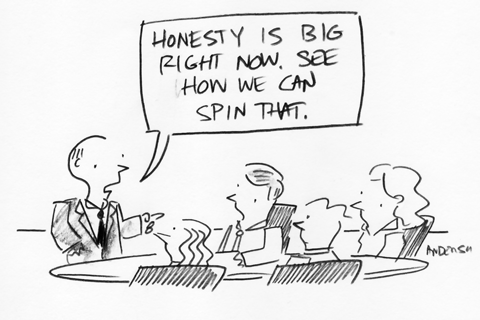
The goal is to quickly communicate the scene. Where is it? Who’s in it? What is this about? You learn a visual shorthand to get those things across and keep the read moving.
For example, the desk and chairs are only partially drawn, but there’s enough to set the scene. The person speaking is clearly indicated. The scene reads left to right smoothly. These are all things a cartoonist needs to consider.
I’ve been doing this a long time, so it only took maybe 15 minutes from my initial sloppy sketch (I looked for it, but apparently it’s been removed to the recycling bin of the ages) to the second cleaned up client-ready sketch above.
Normally my cartoons have a typeset caption underneath, but Jason suggested a cartoon speech bubble to allow for a larger font and easier reading. I don’t particularly like bubbles, but Jason has given his share of presentations, and if he’d prefer a speech bubble, that’s fine.
Jason approved the cartoon and I moved on to the final ink:
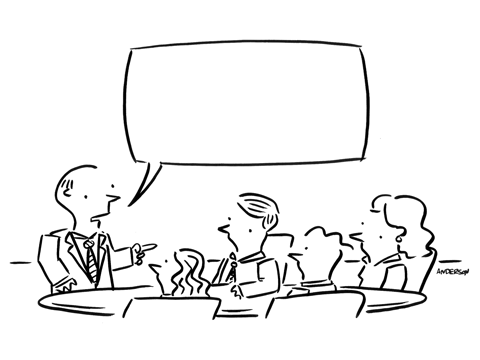
This part goes quickly because all of the heavy lifting of writing and sketching is already finished. The only hiccup being a slight skew in the speech bubble (see why I don’t like them?) that I fixed with a little Photoshop warping.
After the ink is the way I want it, I move on to shading: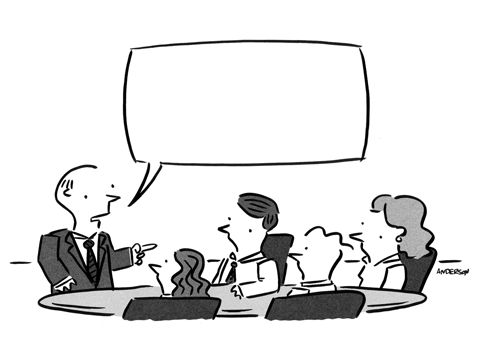
When I’m doing cartoons for Andertoons’ inventory, I normally shade using markers. But for custom clients I use a set of sampled markers I created in Photoshop. It’s less organic, but when used in layers they allow for easier editing to a client’s taste.
After the ink & shade are complete it’s time for the custom cartoon cherry on top, the caption: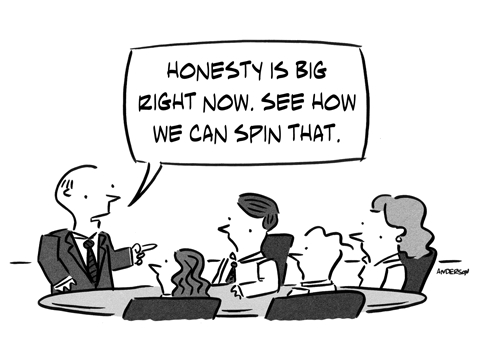
Normally I use Tahoma for a caption underneath, but that kind of font doesn’t fit a speech bubble. I used a font I had made of my own handwriting to finish things up.
After a final spellcheck, a double check of the dimensions, and one more good long look, the cartoon is emailed over and, hopefully, everyone is happy.
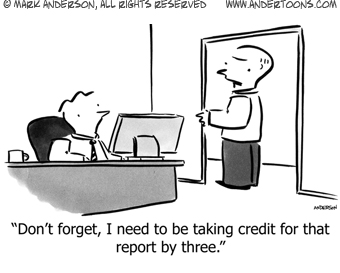 So that’s how it works. I hope you weren’t expecting anything wild or zany. The truth is comedy is serious business, and only those cartoonists who approach it seriously end up with a career drawing funny pictures.
So that’s how it works. I hope you weren’t expecting anything wild or zany. The truth is comedy is serious business, and only those cartoonists who approach it seriously end up with a career drawing funny pictures.
If you’d like to commission a cartoon of your own, please check out my custom cartoons section at Andertoons.com. And thanks again, Jason, for the opportunity not only to draw you a cartoon, but to talk to your readers more at length than my regular captions.

10 responses to “Behind the scenes: Creating custom cartoons”
awesom!!!
I think one of the most underappreciated things in the world is comedy. It takes a lot of work to make something funny, and everyone and their mothers thinks that they can do it.
Hats off to you for having an angle and process for your work, great stuff.
Thanks for posting this…I’ve contacted him. Excellent cartoons.
Here’s a quick idea for one … man says to boss “You say in your email that the negotiation seminar I want take is too expensive. Well if you send me to it I’m sure I can find out how I can go again at a discounted rate.”
Mark? Good? Is that worth a trade for one custom cartoon?
Aw shucks…. thanks all!
Great tips for making cartoons. Humor is best conveyed with restrained visuals and brief lines.
What a thoroughly educational PLUS fascinating guest blog post and set of visuals! Thanks, Mark, for taking on the challenge, and thanks, Jason – for the great idea and what resulted we all can now share an experience of with others.
Thanks for sharing how the sausage is made. Best part was you sharing the rejected lines. Too often we think that for others everything comes out perfect the first time.
Great work!
wonderful toon tips! and best of it’s coming the artist himself. simple. with sense of humor. so i bookmarked it. :) i wanted to draw comics strip too. so i post my on my blog. silly drawings i call it.